
FNR24150 -- Week 13 Notes
Introduction to Feeding & Food Habits
Although some exceptions exist, amphibians and reptiles mostly feed on:
Frogs & salamanders: insects
Turtles: plans & animals (vertebrates & invertebrates)
Squamates: animals (vertebrates & invertebrates)
Projectile Tongues
Commonly found in amphibians (Anurans)
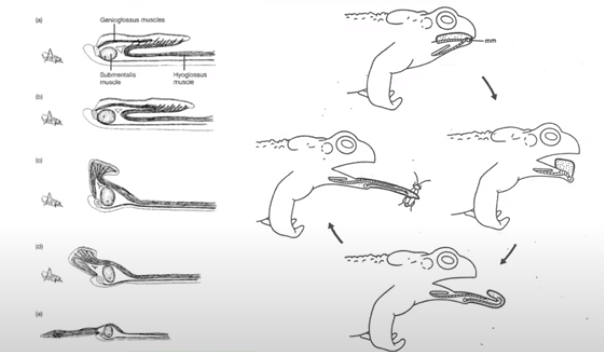
On left:
A: projection; mouth opening
B: tongue flips forward
C: tongue fully extended and turned upside down; dorsal surface of tongue tip encircles prey
D: muscles contract and the retract tongue back inside
Plethodontidae Salamanders
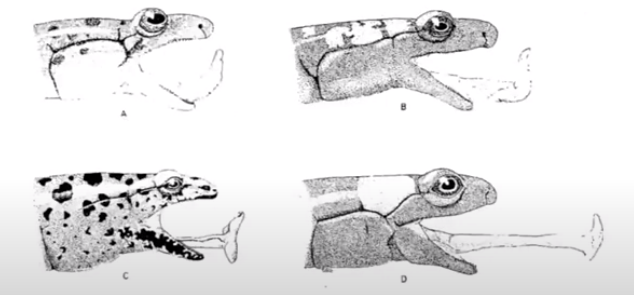
A: minimal protrusion
B: Modest protrusion
C: free tongue and considerable protrusion
D: free tongue and extreme protrusion
In some salamander spp., length of tongue = half length of body
Squamates (Chameleons)
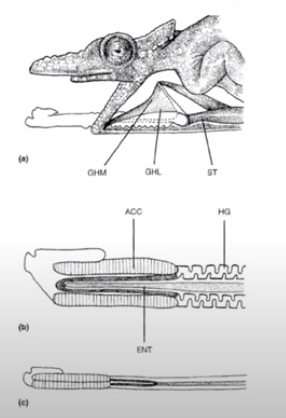
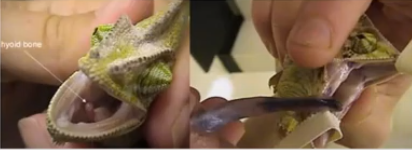
Digestive System
Digestive Glands
Oral cavity
Amphibians: Intermaxillary gland
Secretes a sticky compound that helps prey adhere to the tip of the tongue
Found in both frogs & salamanders
Reptiles: venom glands
Modified salivary glands
Very well-developed
Used to subdue and digest
Opisthoglyph
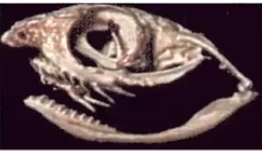
Rear-fanged snakes (back of maxilla)
Fangs not hollow
Weak venom
Due to location of fangs, snake must move prey to back of mouth before digestion
IN: Hognose Snake
Proteroglyph elapid snakes
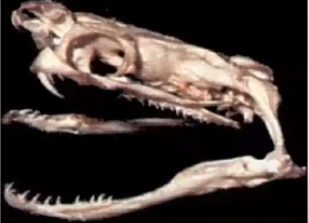
Forward-grooved snakes
Shortened maxillary bearing fangs with few teeth except for enlarged fangs
Fixed fangs with a hollow tube (like a needle/syringe)
Many species are some of the most toxic (neurotoxins)
Due to the shortened nature of its front teeth, it must hold on momentarily to inject the venom
Cobras & Brown Snakes (Australia)
Solenoglyph Viperid Snakes
Most advanced venom delivery method system of any snake
Each maxilla reduced to a nub supporting a single hollow fanged tooth
Fangs can be as long as half the length of head
Gaboon Viper: 2 in long fangs
Folded against roof of mouth (hinged)
Snake opens mouth 180°
Slightly less toxic than proteroglyph; a hemotoxin
Foraging Modes
Two general foraging methods
Sit-and-wait (ambush foraging)
Very little investment in time & energy searching for prey
Most energy spent in capturing & handling prey
Users generally have very good eyesight or special organs (pits organ)
Users rely on cryptic coloration
Active foraging (wide foraging)
Predators are moving through the environment in search of prey
Combination of visual & chemical cues
Larger home range
Higher ATR
Likely a continuum of foraging modes from these two extremes
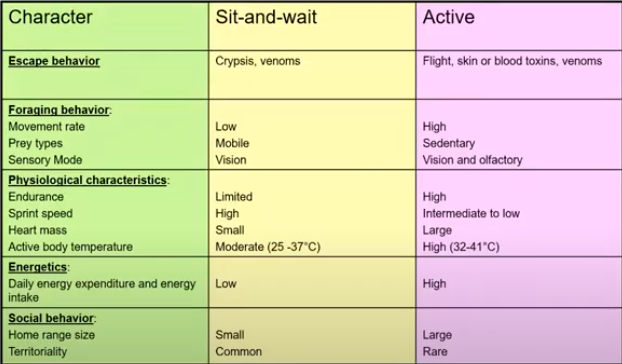
Numerous ecological, behavioural, physiological, and life history parameters that correlate with foraging modes
Factors influencing foraging behaviour
External factors
Prey availability
Predation risk
Societal interactions
Habitat structure
Internal factors
How hungry is it?
Amount of learned experiences (coupled with age)
Sex and reproductive state
Males may not forage since they are protecting their territory; females may forage more to produce enough eggs
Genetics
Phylogenetic factors
Sensory limitations
Morphological characteristics
Physiological constraints
Prey Detection
Amphibians and reptiles can detect prey using different cues
Visual
Mostly used by sit-and-wait predators
Large, well-developed eyes
Discriminate prey based on shape and size
Binocular perception
Can detect depth & distance
Most align heads or entire body axis with that of prey before attacking
Chemical
Olfaction
Prey location identification by sniffing or rapid bugle pumping (frogs inflating their lower mouth)
Long-distance detection system
Main feeding sense of salamanders & lizards
Vomerolfaction (Jacob’s organ)
Sensitive to high molecular weight compounds
Transported to oral and nasal cavities by the snout or tongue
Short-range detection system
Main feeding sense in some salamanders & most snakes
Snakes have bifurcated tongues (provides directionality of info)
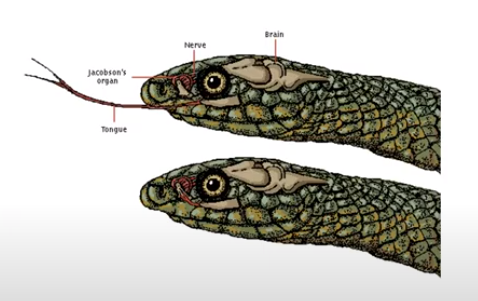
Tongue flicks and picks up high molecular weight compounds
Snake retracts tongue into set of grooves in upper snout in maxilla
Forks transfer compounds into epithelial cells in Jacobson’s Organ
Taste
Help distinguish food items from non-food items
Tactile
Relatively poorly understood
Mechanoreceptors in the skin (lateral line in aquatic amphibians)
In several spp., flaps of skin are highly innervated and also help in the tactile detection of prey
Thermal
Infrared light sensed by nerve endings in skin of head which are located inside pit organs
Loreal pits in vipers
Nasal/upper labial pits in pythons and boas
Pits open anteriorly (always face forward) and provide a binocular
Most effective for nocturnal spp. that feed on mammals & birds
Many spp. use some combination of these cues
Prey Capture & Ingestion
Prey Capture
Biting and grasping
Prey typically swallowed whole
Constriction
Common in boas & pythons
Injected venoms
Hemotoxins, neurotoxins
Filter feeding
Tadpoles: large buccopharyngeal cavities
Suction feeding
Prey is vacuumed into mouth
Projectile tongues
Food Habits
Specific food habits depend on:
Feeding adaptations of animal
Size of animal and prey-capturing methods
Habitat
Relative abundance and size of prey available at time of feeding
Communication: Types
Social behaviour
An interaction with one or more conspecifics and occasionally with individuals of different species as well
Communication
Transfer of information from a signaler to a receiver
4 basic types
Visual
Distinct colors/body movement
Acoustic
Vocalization/rubbing body parts together
Chemical
Odors
Well-developed in salamanders, lizards, and some snakes
Tactile
Individual rubs/presses/hits a body part against another individual
Advantages for communication
Identify & locate mates in a complex environment
Communication: Salamanders
Chemical cues
Salamanders use pheromones
Hormones are produced by courtship glands
Tactical cues
Mate location in Plethodontid salamanders aided by nose-tapping
Also bite, slap, or rub part of their bodies against each other

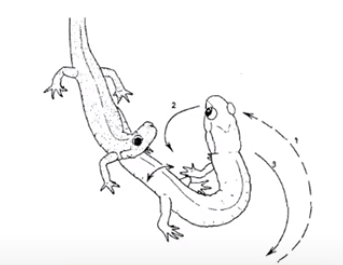
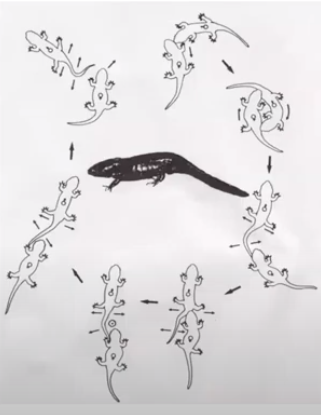
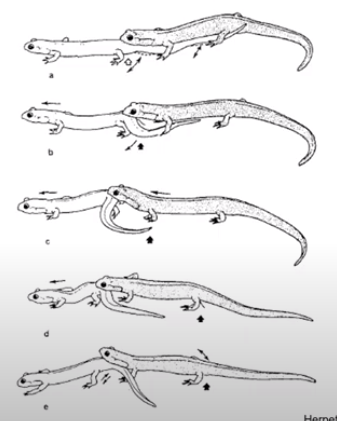
Communication: Frogs
Acoustic cues
Very important
4 basic call categories
Advertisement
Attract mates
Deeper = better
Reciprocation
Very rare
Female calls in response to male
Release
Males amplexing other males, so a release call is made by the one being amplexed
Distress
Grasped by predator
Frogs can make vocalizations by passing air back and forth between lungs, vocal cords, and vocal sacs
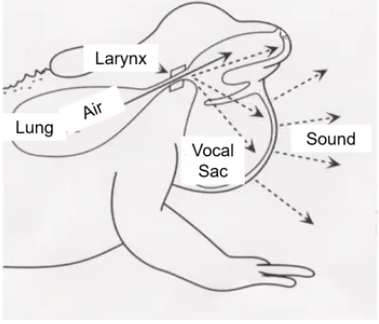
Visual cues
Bright colorations
Mostly in diurnal spp.
Communication: Turtles
Visual cues
Headbobs
Tactile cues
Ram, flip, trailing, biting, tickling
Chemical cues
Special glands on bridge of shells
Cloacal secretions may also play a role
Communication: Lizards
Visual cues
Coloration of dewlaps, heads and sides of the body in males and bright coloration in females
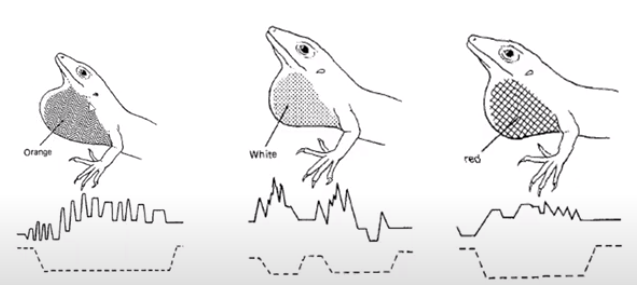
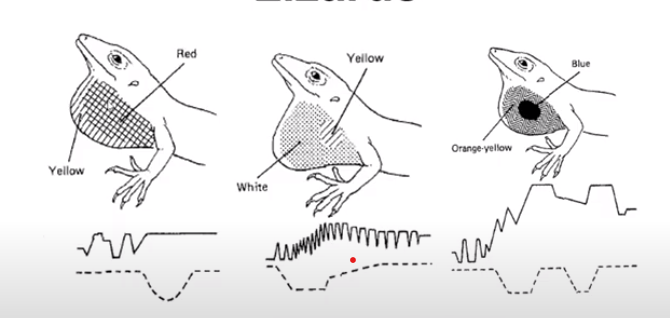

Chemical cues
Pheromones (skinks)
Tactile cues
Tongue flicking
Neck & body scratching
Communication: Snakes
Tactile signals very important for snake courtship
3 different phases
Tactile phase
A lot of chemosensory sampling of males to determine sex of the individual
Male chases female to copulate
Intromission & copulation
Group Behaviour: Competition
Competition
Interspecific
Occasionally occurs among related spp.; frequently congregating spp. partition habitat temporally (especially during breeding)
Different spp. in ephemeral ponds organize by spp. and by time of day
Intraspecific
Occasionally occurs when resources are limited; minimized in larval/juvenile forms
Group Behaviour: Cooperation
2 forms
Hibernation
Different spp. of snakes hibernating together to reduce evaporative loss during winter
Breeding Aggregations
Male frogs taking turns to call a female (reduces intraspecific competition)
FNR24150 -- Week 13 Notes
Introduction to Feeding & Food Habits
Although some exceptions exist, amphibians and reptiles mostly feed on:
Frogs & salamanders: insects
Turtles: plans & animals (vertebrates & invertebrates)
Squamates: animals (vertebrates & invertebrates)
Projectile Tongues
Commonly found in amphibians (Anurans)

On left:
A: projection; mouth opening
B: tongue flips forward
C: tongue fully extended and turned upside down; dorsal surface of tongue tip encircles prey
D: muscles contract and the retract tongue back inside
Plethodontidae Salamanders

A: minimal protrusion
B: Modest protrusion
C: free tongue and considerable protrusion
D: free tongue and extreme protrusion
In some salamander spp., length of tongue = half length of body
Squamates (Chameleons)


Digestive System
Digestive Glands
Oral cavity
Amphibians: Intermaxillary gland
Secretes a sticky compound that helps prey adhere to the tip of the tongue
Found in both frogs & salamanders
Reptiles: venom glands
Modified salivary glands
Very well-developed
Used to subdue and digest
Opisthoglyph

Rear-fanged snakes (back of maxilla)
Fangs not hollow
Weak venom
Due to location of fangs, snake must move prey to back of mouth before digestion
IN: Hognose Snake
Proteroglyph elapid snakes

Forward-grooved snakes
Shortened maxillary bearing fangs with few teeth except for enlarged fangs
Fixed fangs with a hollow tube (like a needle/syringe)
Many species are some of the most toxic (neurotoxins)
Due to the shortened nature of its front teeth, it must hold on momentarily to inject the venom
Cobras & Brown Snakes (Australia)
Solenoglyph Viperid Snakes
Most advanced venom delivery method system of any snake
Each maxilla reduced to a nub supporting a single hollow fanged tooth
Fangs can be as long as half the length of head
Gaboon Viper: 2 in long fangs
Folded against roof of mouth (hinged)
Snake opens mouth 180°
Slightly less toxic than proteroglyph; a hemotoxin
Foraging Modes
Two general foraging methods
Sit-and-wait (ambush foraging)
Very little investment in time & energy searching for prey
Most energy spent in capturing & handling prey
Users generally have very good eyesight or special organs (pits organ)
Users rely on cryptic coloration
Active foraging (wide foraging)
Predators are moving through the environment in search of prey
Combination of visual & chemical cues
Larger home range
Higher ATR
Likely a continuum of foraging modes from these two extremes

Numerous ecological, behavioural, physiological, and life history parameters that correlate with foraging modes
Factors influencing foraging behaviour
External factors
Prey availability
Predation risk
Societal interactions
Habitat structure
Internal factors
How hungry is it?
Amount of learned experiences (coupled with age)
Sex and reproductive state
Males may not forage since they are protecting their territory; females may forage more to produce enough eggs
Genetics
Phylogenetic factors
Sensory limitations
Morphological characteristics
Physiological constraints
Prey Detection
Amphibians and reptiles can detect prey using different cues
Visual
Mostly used by sit-and-wait predators
Large, well-developed eyes
Discriminate prey based on shape and size
Binocular perception
Can detect depth & distance
Most align heads or entire body axis with that of prey before attacking
Chemical
Olfaction
Prey location identification by sniffing or rapid bugle pumping (frogs inflating their lower mouth)
Long-distance detection system
Main feeding sense of salamanders & lizards
Vomerolfaction (Jacob’s organ)
Sensitive to high molecular weight compounds
Transported to oral and nasal cavities by the snout or tongue
Short-range detection system
Main feeding sense in some salamanders & most snakes
Snakes have bifurcated tongues (provides directionality of info)

Tongue flicks and picks up high molecular weight compounds
Snake retracts tongue into set of grooves in upper snout in maxilla
Forks transfer compounds into epithelial cells in Jacobson’s Organ
Taste
Help distinguish food items from non-food items
Tactile
Relatively poorly understood
Mechanoreceptors in the skin (lateral line in aquatic amphibians)
In several spp., flaps of skin are highly innervated and also help in the tactile detection of prey
Thermal
Infrared light sensed by nerve endings in skin of head which are located inside pit organs
Loreal pits in vipers
Nasal/upper labial pits in pythons and boas
Pits open anteriorly (always face forward) and provide a binocular
Most effective for nocturnal spp. that feed on mammals & birds
Many spp. use some combination of these cues
Prey Capture & Ingestion
Prey Capture
Biting and grasping
Prey typically swallowed whole
Constriction
Common in boas & pythons
Injected venoms
Hemotoxins, neurotoxins
Filter feeding
Tadpoles: large buccopharyngeal cavities
Suction feeding
Prey is vacuumed into mouth
Projectile tongues
Food Habits
Specific food habits depend on:
Feeding adaptations of animal
Size of animal and prey-capturing methods
Habitat
Relative abundance and size of prey available at time of feeding
Communication: Types
Social behaviour
An interaction with one or more conspecifics and occasionally with individuals of different species as well
Communication
Transfer of information from a signaler to a receiver
4 basic types
Visual
Distinct colors/body movement
Acoustic
Vocalization/rubbing body parts together
Chemical
Odors
Well-developed in salamanders, lizards, and some snakes
Tactile
Individual rubs/presses/hits a body part against another individual
Advantages for communication
Identify & locate mates in a complex environment
Communication: Salamanders
Chemical cues
Salamanders use pheromones
Hormones are produced by courtship glands
Tactical cues
Mate location in Plethodontid salamanders aided by nose-tapping
Also bite, slap, or rub part of their bodies against each other




Communication: Frogs
Acoustic cues
Very important
4 basic call categories
Advertisement
Attract mates
Deeper = better
Reciprocation
Very rare
Female calls in response to male
Release
Males amplexing other males, so a release call is made by the one being amplexed
Distress
Grasped by predator
Frogs can make vocalizations by passing air back and forth between lungs, vocal cords, and vocal sacs

Visual cues
Bright colorations
Mostly in diurnal spp.
Communication: Turtles
Visual cues
Headbobs
Tactile cues
Ram, flip, trailing, biting, tickling
Chemical cues
Special glands on bridge of shells
Cloacal secretions may also play a role
Communication: Lizards
Visual cues
Coloration of dewlaps, heads and sides of the body in males and bright coloration in females



Chemical cues
Pheromones (skinks)
Tactile cues
Tongue flicking
Neck & body scratching
Communication: Snakes
Tactile signals very important for snake courtship
3 different phases
Tactile phase
A lot of chemosensory sampling of males to determine sex of the individual
Male chases female to copulate
Intromission & copulation
Group Behaviour: Competition
Competition
Interspecific
Occasionally occurs among related spp.; frequently congregating spp. partition habitat temporally (especially during breeding)
Different spp. in ephemeral ponds organize by spp. and by time of day
Intraspecific
Occasionally occurs when resources are limited; minimized in larval/juvenile forms
Group Behaviour: Cooperation
2 forms
Hibernation
Different spp. of snakes hibernating together to reduce evaporative loss during winter
Breeding Aggregations
Male frogs taking turns to call a female (reduces intraspecific competition)
 Knowt
Knowt
